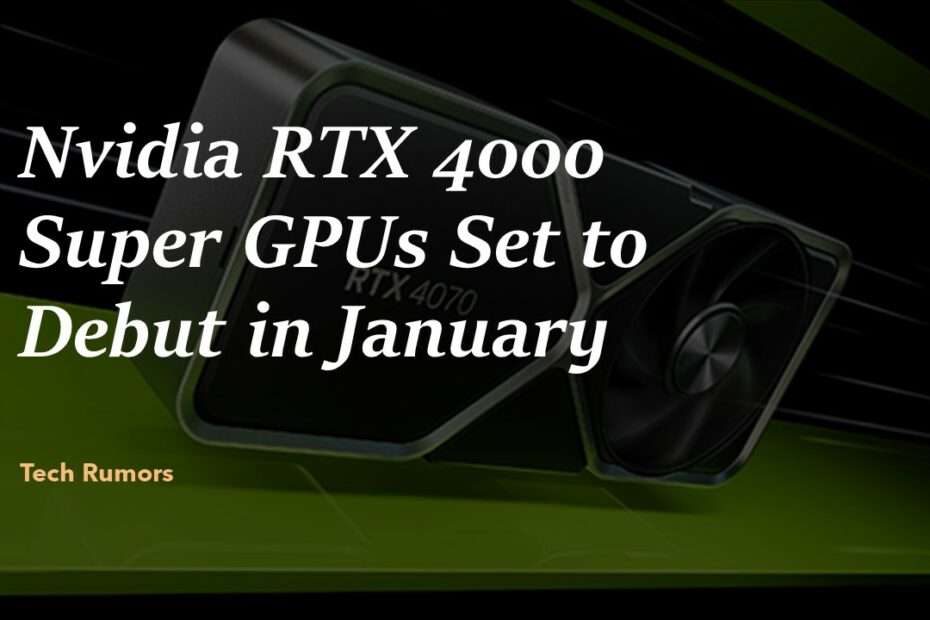The unconfirmed details emerging from trusted leakers not only offer a glimpse into the potential specifications and features of the RTX 4000 Super GPUs but also provide enthusiasts with a tentative timeline for their debut. If these predictions hold true, the weeks post-CES could witness a series of unveilings, creating a buzz of activity as Nvidia introduces each GPU in a strategic rollout. As the tech world eagerly awaits the official announcement from Nvidia, the well-established credibility of these leakers adds credibility to the speculated release dates, further fueling the anticipation surrounding the next generation of graphics processing units.
According to a report from Chinese hardware outlet IT Home, the release dates for Nvidia’s anticipated GeForce RTX 4000 Super series have been revealed. The information suggests a staggered release schedule, with the GeForce RTX 4070 Super set to be available on January 17, followed by the RTX 4070 Ti Super on January 24, and the RTX 4080 Super on January 31. These specific dates provide enthusiasts with a clear timeline for the availability of each GPU in the series, adding to the growing excitement surrounding Nvidia’s upcoming product launch.
Earlier details align with this reported release schedule, as Nvidia is said to be planning a special address on January 8, one day before the commencement of CES. This dedicated event is expected to serve as the official unveiling of the RTX 4000 Super series, offering a comprehensive look at the features, specifications, and innovations that the new lineup brings to the table. With the confirmed dates and the impending showcase, the tech community eagerly awaits Nvidia’s official announcement and the subsequent release of these highly anticipated graphics cards.
Recent reports from IT Home and other reliable sources have reaffirmed earlier leaked information regarding the specifications of Nvidia’s upcoming RTX 4000 Super series. These sources indicate that each card in the new lineup is anticipated to deliver superior performance compared to its non-Super predecessor. Remarkably, this performance boost is expected to come at a similar or only slightly higher price point, making the new GPUs an attractive proposition for enthusiasts and gamers alike. Additionally, the thermal design power (TDP) of these cards is projected to remain competitive, ensuring efficient performance without compromising on power consumption. With these improvements, the RTX 4000 Super series is poised to replace the original high-end RTX 4000 cards, marking a strategic shift in Nvidia’s production and offering users an enhanced and more cost-effective graphics solution.

The upcoming RTX 4070 Super is set to impress with its choice of GPUs—either the AD104-350 or AD103-175—equipped with a substantial 7,168 cores. This significant increase in core count, approximately 21 percent more than its predecessor, positions the RTX 4070 Super as a powerhouse, potentially rivaling the original RTX 4070 Ti. The boost in cores indicates a substantial improvement in processing capability, promising users a more robust and efficient graphics performance. Despite these enhancements, the anticipated price for the RTX 4070 Super is expected to maintain affordability, with a speculated range of $599 to $649.
As Nvidia continues to push the boundaries of graphics card technology, the RTX 4070 Super’s specifications suggest a noteworthy leap in performance. The increase in core count not only positions the card as a strong contender within its series but also sets the stage for a competitive market presence. With the potential to nearly match the capabilities of the original RTX 4070 Ti, the RTX 4070 Super aims to offer an impressive blend of enhanced performance and reasonable pricing, making it an attractive option for gamers and enthusiasts looking for cutting-edge graphics solutions without breaking the bank.
Contrary to prior doubts expressed in leaks, the latest information indicates a strong possibility of the RTX 4070 Ti Super being launched. This revelation provides enthusiasts and consumers with an exciting prospect, as the card promises a significant leap in both core count and VRAM capacity. The decision to proceed with the release suggests Nvidia’s commitment to offering a diverse and comprehensive range of graphics solutions. As the tech community eagerly awaits the official confirmation, the RTX 4070 Ti Super stands poised to deliver an impressive combination of cutting-edge technology and heightened performance for users who prioritize high-end graphics capabilities.
The forthcoming RTX 4080 Super introduces a more conservative improvement, with a modest 6-9 percent boost in performance. This enhancement is achieved through the utilization of the AD103-400 GPU, equipped with an impressive 10,240 cores. While the performance uplift may not be as substantial as some of its counterparts, the RTX 4080 Super still positions itself as a formidable option within the high-end graphics card market. Importantly, the price of the RTX 4080 Super experiences a notable drop, decreasing from $1,199 to a more accessible $999. This price adjustment enhances the card’s appeal, making it an attractive choice for users seeking a balance between powerful performance and reasonable pricing in the upper echelons of the graphics card market.
The upcoming RTX 4000 Super series appears to address the concerns and expectations that users had during the Ada Lovelace generation. Users were disappointed with the marginal performance improvements that failed to sufficiently justify the price hikes seen with the RTX 3000 series. The new lineup, with its substantial core count increases, performance boosts, and competitive pricing, seems poised to deliver on the desired improvements that users were hoping for. In particular, the expansion of the RTX 4070 Ti’s memory from 12 GB to 16 GB stands out as a noteworthy enhancement. This move is likely to be well-received by users, especially those engaged in resource-intensive tasks such as gaming and content creation, where larger VRAM capacities contribute to a smoother and more immersive experience.
The RTX 4000 Super series, by aligning more closely with customer expectations, signals Nvidia’s responsiveness to user feedback and a commitment to delivering a more compelling product offering. The adjustments made, such as the significant core count increases and the thoughtful expansion of VRAM, indicate a strategic approach to addressing the concerns expressed by the user base. With these improvements, the new lineup aims to strike a better balance between performance and pricing, catering to the demands of a discerning user community that seeks value and innovation in the rapidly evolving landscape of graphics processing technology.
As the graphics card landscape evolves, the competition between Nvidia and AMD continues to drive innovation and affordability. Looking ahead, there are expectations that AMD might introduce a GPU in the coming year that can rival the performance of one of the RTX 4000 Super cards, all at a price point below $600.
In response to the anticipated competition, Nvidia is already gearing up for the future. There are speculations that Nvidia’s next move involves the introduction of the RTX 5000 series, based on a 3nm architecture. This new series is expected to be unveiled either later in 2024 or sometime in 2025. The move to a 3nm process node suggests a commitment to pushing the boundaries of performance and efficiency, setting the stage for another leap in graphics technology. As these developments unfold, the graphics card market is poised for exciting changes, with both Nvidia and AMD vying to deliver cutting-edge products that cater to the diverse needs of users across different budgets.
Maybe you liked other articles?

